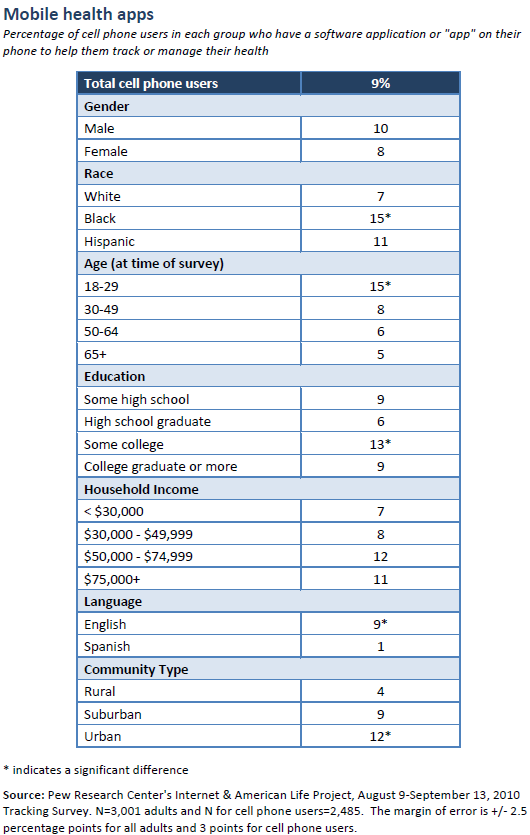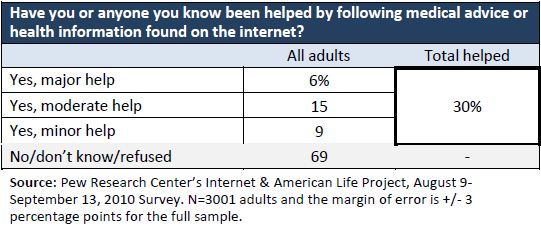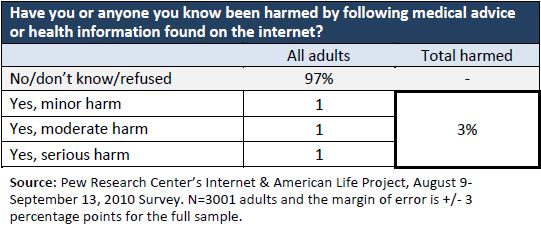Health professionals and offline resources are central, but people use online social tools, too.
This report sets out to illuminate the different ways people seek health information as well as how people use online social tools to share knowledge with loved ones, fellow patients, and caregivers.
When asked to think about the last time they had a health issue, 71% of adults in the U.S. say they received information, care, or support from a health professional. Fifty-five percent of adults say they received such help from friends and family. Twenty-one percent of adults say they turned to others who have the same health condition for information, care, or suppport. The vast majority of respondents say those interactions happened offline.
However, three-quarters of U.S. adults (74%) use the internet and, of those, many participate in an online conversation about health. For example:
- 80% of internet users have looked online for information about any one of 15 health topics such as a specific disease or treatment. This translates to 59% of all adults.
- 34% of internet users have read someone else’s commentary or experience about health or medical issues on an online news group, website, or blog.
- 14% of internet users have signed up to receive email updates or alerts about health or medical issues.
- 6% of internet users have posted comments, questions or information about health or medical issues on a website of some kind, such as a health site or news site that allows comments and discussion.
- 5% of internet users have posted health-related comments, questions, or information in an online discussion, a listserv, or other online group forum.
- 4% of internet users have posted such comments, questions or information on a blog.
These findings are similar to those we reported in 2009.
This survey is the first time we collected the following data point:
- 25% of internet users have watched an online video about health or medical issues.
Internet users living with one or more chronic conditions are more likely than those who report no conditions to have done three of the above activities: 37% have read someone else’s health commentary online (vs. 31% of those reporting no chronic conditions), 31% have watched a health video online (vs. 22% of those reporting no chronic conditions), and 23% have signed up to receive email updates about certain health topics (vs. 9% of those reporting no chronic conditions).
Wireless users outpace other internet users on every one of the above activities by significant margins. For example, 37% of wireless users have read about someone else’s health experience online, compared with 24% of other internet users. Twenty-seven percent of wireless users have watched an online health video, compared with 21% of other users.
Social network sites are popular, but used only sparingly for health updates and queries.
As of September 2010, 62% of adult internet users report using a social network site like MySpace or Facebook. Of that group:
- 23% of social networking site users have followed their friends’ personal health experiences or updates on the site. This translates to 11% of all adults.
- 17% have used social network sites to remember or memorialize other people who suffered from a certain health condition.
- 15% have gotten any health information on the sites.
- 14% have raised money for or drawn attention to a health-related issue or cause.
- 11% have posted comments, queries, or information about health or medical matters.
- 9% have started or joined a health-related group on a social networking site.
People caring for loved ones are more likely than other adults to use social network sites to gather and share health information and support.
More than a quarter of adults in the U.S. provide unpaid care to a loved one. Twenty-seven percent of adults care for an adult relative or friend; 5% of adults care for a child with a health condition or disability.10
Caregivers are one group that is significantly more likely than others to use social network sites for health-related pursuits: 28% of caregivers who use social networks sites say they follow friends’ health updates, compared with 21% of other social network site users. Twenty percent of caregivers who use social network sites say they have gathered health information on such a site, compared with 12% of other users.
Social network sites are not a significant source of health information for most people, but they can be a source of encouragement and care. In a book about social support, Consequential Strangers, authors Melinda Blau and Karen Fingerman write about how people in our wide circles of acquaintance “offer practical assistance, firsthand information, and a special brand of no-strings emotional comfort.”11
On a practical level, the vast majority of people living with chronic conditions never attend traditional, in-person support group meetings, although studies show they could benefit from such groups.12 Instead, people often mobilize their “social convoy” of family members, friends, colleagues, fellow patients, and fellow caregivers – many of whom are now connected online via email, social network sites, or by other means. As Blau and Fingerman describe it:
A natural network provides a safety net and puts the patient in charge—a good balance in any situation. Think of it as customizing your convoy. If people who are already on board don’t have the information, experience, or empathy you need, you enlist others who do.13
In a pattern that matches this observation, people living with one or more chronic conditions and those living with disability14 are significantly more likely than other social network site users to gather health information on these sites. Twenty percent of social network site users living with chronic conditions do so, compared with 12% of social network site users who report no chronic conditions. Twenty-three percent of social network site users living with disability get health information on these sites, compared with 13% of those who report no disability.
Relatively few use hospital ranking and doctor review sites.
Hospital and doctor review sites have not yet become health care decision-making tools for most consumers. One national survey found that only 6% of American adults are aware of the Centers for Medicare & Medicaid’s Hospital Compare tool.15 Our current survey finds a similarly low usage of such sites among adult internet users, matching trends we first reported in 2009.16
- 16% of internet users have consulted online rankings or reviews of doctors or other providers.
- 15% of internet users have consulted online rankings or reviews of hospitals or other medical facilities.
- 4% of internet users have posted a review online of a doctor.
- 3% of internet users have posted a review online of a hospital.
Again, caregivers are more likely than other groups to engage in these activities. For example, 21% of online caregivers consult online doctor reviews, compared with 13% of internet users not currently caring for a loved one. Twenty percent of online caregivers consult online hospital reviews, compared with 12% of other internet users.
Eighteen percent of internet users living with one or more chronic conditions have looked online for doctor rankings or reviews, compared with 14% of internet users who report no conditions. Six percent of internet users living with chronic disease have posted such a review, compared with 3% of those who report no conditions. Both of those differences are statistically significant, but more importantly, they are significant because of the context of who is most likely to be a frequent health care consumer: someone living with a chronic condition.
Internet users living with disability do not report a higher or lower likelihood to consult hospital rankings and doctor reviews. However, they are more likely than other internet users to post reviews of doctors and other health professionals online: 8% do so, compared with 4% of those who report no disability.
One in four adult internet users have consulted online reviews of drugs or treatments.
In November 2009, the U.S. Food and Drug Administration held a public hearing on how companies use the internet, particularly social media, to promote prescription drugs, medical devices, and other regulated products.17 No regulations have been issued to date. But because of this heightened interest in how consumers gather and share information about drugs, we added a new category of online reviews to the current survey and find:
- 24% of internet users have consulted online reviews of particular drugs or medical treatments.
- 4% of internet users have posted their experiences with a particular drug or medical treatment.
Fully 38% of online caregivers have consulted online drug reviews, compared with 18% of internet users who do not take care of a loved one. Seven percent of online caregivers have posted such a review, compared with just 2% of other internet users.
Thirty-one percent of internet users living with one or more chronic conditions have looked at online drug reviews, compared with 20% of internet users reporting no conditions. Six percent of internet users living with chronic disease have posted an online review of a drug or treatment, compared with 2% of those with no conditions.
Internet users living with disability are just as likely as other people to look up drug reviews, but they are more likely than other people to say they have posted their own treatment experiences online. Nine percent of internet users living with disability say they have posted a review of a drug or treatment, compared with 2% of those who report no disability.
In a separate question we find that 24% of internet users say they go online to look for information about drug safety or recalls.18
One in four adult internet users track their own health data online.
Carol Torgan, a health science strategist, points out that anyone who makes note of their blood pressure, weight, or menstrual cycle could be categorized as a “self-tracker.”19 Add an online component, and you have the ingredients for a social health application or an electronic health record. Our survey finds that 15% of internet users have tracked their weight, diet, or exercise routine online. In addition, 17% of internet users have tracked any other health indicators or symptoms online. Fully 27% of adult internet users say yes to either question.
Wireless users are more likely than other internet users to track health data online. Eighteen percent of wireless users have tracked their weight, diet, or exercise routine online, compared with 9% of internet users who do not have a wireless-enabled laptop or other device. Nineteen percent of wireless users have tracked any other health indicators or symptoms online, compared with 11% of non-wireless internet users.
Separately, looking just at the 85% of adults who own a cell phone, 9% say they have software applications or “apps” on their phones that help them track or manage their health.

More people report being helped, rather than harmed, by online health information.
One in three adults in the U.S. (30%) say they or someone they know has been helped by following medical advice or health information found online.

Fully 44% of caregivers report that online health resources have been helpful. Adults who went through a recent personal health change – gaining or losing a lot of weight, becoming pregnant, or quitting smoking – are also especially likely to report being helped by online resources: 40% do so, compared with 28% of other adults.
Ten percent of adults living with two or more chronic conditions – unfortunately a large and growing slice of the population in the U.S. – say they or someone they know has received major help from online health information, compared with 5% of adults who report no conditions.
Just 3% of adults say they or someone they know has been harmed.





